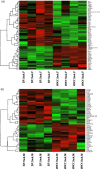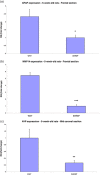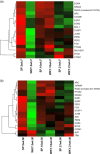Differential gene expression in multiple neurological, inflammatory and connective tissue pathways in a spontaneous model of human small vessel stroke
- PMID: 24417612
- PMCID: PMC4260148
- DOI: 10.1111/nan.12116
Differential gene expression in multiple neurological, inflammatory and connective tissue pathways in a spontaneous model of human small vessel stroke
Abstract
Aims: Cerebral small vessel disease (SVD) causes a fifth of all strokes plus diffuse brain damage leading to cognitive decline, physical disabilities and dementia. The aetiology and pathogenesis of SVD are unknown, but largely attributed to hypertension or microatheroma.
Methods: We used the spontaneously hypertensive stroke-prone rat (SHRSP), the closest spontaneous experimental model of human SVD, and age-matched control rats kept under identical, non-salt-loaded conditions, to perform a blinded analysis of mRNA microarray, qRT-PCR and pathway analysis in two brain regions (frontal and mid-coronal) commonly affected by SVD in the SHRSP at age five, 16 and 21 weeks.
Results: We found gene expression abnormalities, with fold changes ranging from 2.5 to 59 for the 10 most differentially expressed genes, related to endothelial tight junctions (reduced), nitric oxide bioavailability (reduced), myelination (impaired), glial and microglial activity (increased), matrix proteins (impaired), vascular reactivity (impaired) and albumin (reduced), consistent with protein expression defects in the same rats. All were present at age 5 weeks thus predating blood pressure elevation. 'Neurological' and 'inflammatory' pathways were more affected than 'vascular' functional pathways.
Conclusions: This set of defects, although individually modest, when acting in combination could explain the SHRSP's susceptibility to microvascular and brain injury, compared with control rats. Similar combined, individually modest, but multiple neurovascular unit defects, could explain susceptibility to spontaneous human SVD.
Keywords: blood brain barrier; lacunar stroke; neurovascular unit; small vessel disease; stroke.
© 2014 The Authors. Neuropathology and Applied Neurobiology published by John Wiley & Sons Ltd on behalf of British Neuropathological Society.
Figures






Similar articles
-
Effects of dietary salt on gene and protein expression in brain tissue of a model of sporadic small vessel disease.Clin Sci (Lond). 2018 Jun 26;132(12):1315-1328. doi: 10.1042/CS20171572. Print 2018 Jun 29. Clin Sci (Lond). 2018. PMID: 29632138 Free PMC article.
-
Cerebral small vessel endothelial structural changes predate hypertension in stroke-prone spontaneously hypertensive rats: a blinded, controlled immunohistochemical study of 5- to 21-week-old rats.Neuropathol Appl Neurobiol. 2011 Dec;37(7):711-26. doi: 10.1111/j.1365-2990.2011.01170.x. Neuropathol Appl Neurobiol. 2011. PMID: 21392049
-
Gene expression suggests spontaneously hypertensive rats may have altered metabolism and reduced hypoxic tolerance.Curr Neurovasc Res. 2012 Feb;9(1):10-9. doi: 10.2174/156720212799297074. Curr Neurovasc Res. 2012. PMID: 22272763 Free PMC article.
-
New insights into mechanisms of small vessel disease stroke from genetics.Clin Sci (Lond). 2017 Apr 1;131(7):515-531. doi: 10.1042/CS20160825. Clin Sci (Lond). 2017. PMID: 28302914 Review.
-
Cerebral small vessel disease: Recent advances and future directions.Int J Stroke. 2023 Jan;18(1):4-14. doi: 10.1177/17474930221144911. Int J Stroke. 2023. PMID: 36575578 Free PMC article. Review.
Cited by
-
Interplay between Brain Pericytes and Endothelial Cells in Dementia.Am J Pathol. 2021 Nov;191(11):1917-1931. doi: 10.1016/j.ajpath.2021.07.003. Epub 2021 Jul 27. Am J Pathol. 2021. PMID: 34329605 Free PMC article. Review.
-
Altered Extracellular Vesicle MicroRNA Expression in Ischemic Stroke and Small Vessel Disease.Transl Stroke Res. 2019 Oct;10(5):495-508. doi: 10.1007/s12975-018-0682-3. Epub 2019 Jan 7. Transl Stroke Res. 2019. PMID: 30617992 Free PMC article.
-
Effects of dietary salt on gene and protein expression in brain tissue of a model of sporadic small vessel disease.Clin Sci (Lond). 2018 Jun 26;132(12):1315-1328. doi: 10.1042/CS20171572. Print 2018 Jun 29. Clin Sci (Lond). 2018. PMID: 29632138 Free PMC article.
-
Pericytes and Extracellular Vesicle Interactions in Neurovascular Adaptation to Chronic Arterial Hypertension.J Am Heart Assoc. 2025 Jan 7;14(1):e038457. doi: 10.1161/JAHA.124.038457. Epub 2024 Dec 24. J Am Heart Assoc. 2025. PMID: 39719419 Free PMC article.
-
Characterizing the Neuroimaging and Histopathological Correlates of Cerebral Small Vessel Disease in Spontaneously Hypertensive Stroke-Prone Rats.Front Neurol. 2021 Nov 30;12:740298. doi: 10.3389/fneur.2021.740298. eCollection 2021. Front Neurol. 2021. PMID: 34917012 Free PMC article.
References
-
- Baezner H, Blahak C, Poggesi A, Pantoni L, Inzitari D, Chabriat H, Erkinjuntti T, Fazekas F, Ferro JM, Langhorne P, O'Brien J, Scheltens P, Visser MC, Wahlund LO, Waldemar G, Wallin A, Hennerici MG. Association of gait and balance disorders with age-related white matter changes: the LADIS study. Neurology. 2008;70:935–942. - PubMed
-
- Fisher CM. The arterial lesions underlying lacunes. Acta Neuropathol. 1968;12:1–15. - PubMed
Publication types
MeSH terms
Substances
Grants and funding
LinkOut - more resources
Full Text Sources
Other Literature Sources

